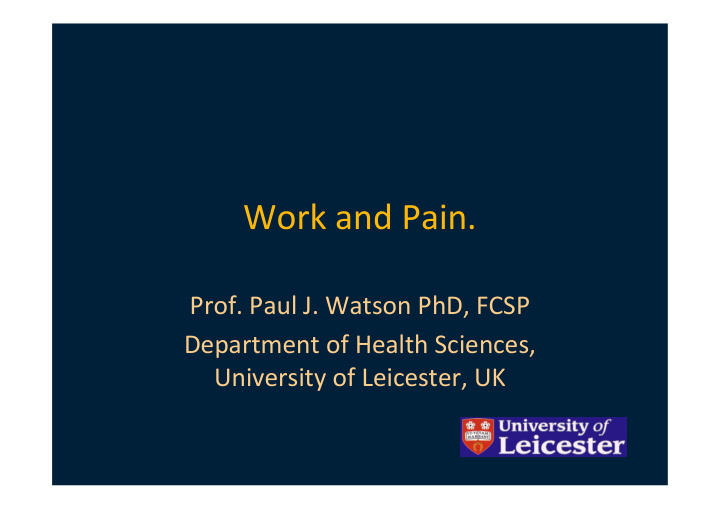



Work and Pain. Prof. Paul J. Watson PhD, FCSP Department of Health Sciences, University of Leicester, UK
Provision of Occupational Health � Hussey (2009) 12% – 34% of population in the UK has access to Occupational Health lowest provision in SMEs � Only Greece has lower OH provision in Europe � UK has one of the lowest sickness absence rates in the EU (CIPD 2008). � OH provision alone might not be related to sickness absence rates. � Need for evidence based service provision.
New onset of LBP: Return to work Vs pain and disability report ������������������ ��������� ����������
The most popular medication?
Do clinicians beliefs affect consultation and treatment outcomes? � Biomedical orientation on LBP related to increased clinician choice of � Recommendations to rest � Passive treatment choices (drugs, interventions) � Advice to avoid work � Sickness certification � Psychosocial orientation � Active rehabilitation approaches � Advice to remain at work/remain active
Why do people get a sick note for back pain? � Logistic regression for certification for low back pain by GPs � Pt variables � Years in education � Previous work absences for LBP* � Pain intensity � RMDQ � FABQ work* � Sensitivity 74.5%, specificity 75%, over all 74.7% (Morris and Watson EJP 2010 )
Sickness certification for back pain � GP variables in the model � Years as GP* � History of LBP � PABS-GP biomedical � PABS-GP Biopsychosocial scale* � Sensitivity 68.5% Specificity 69.1% (Morris and Watson EJP 2010 )
Combined model � Patient variables- previous work absence, high fear avoidance beliefs � GP variables - Increased years as a GP and lower scores on BPS scale were significant. � Sensitivity 81.1%, specificity 83.3%, overall 82.2% (Morris and Watson EJP 2010 )
Some jobs are not conducive to good health
People with chronic pain become unemployed Period of unemployment is associated with � Increased mortality � Increased mental health problems � Increase drug and alcohol abuse � Increased physical health problems Good work is good for you!
Work, healthcare, employment � Qualitative research of patients with low back pain. � Investigate patients experiences of � working with pain � Advice regarding work � Rehabilitation opportunities � Assistance in returning to work � People working with LBP, returned to work, unemployed due to CLBP.
Qualitative research: Results � Healthcare practitioners do not give useful advice on return to work. � No communication between HCPs and workplace � Felt GPs do not feel it is their role to facilitate RTW. � Patient sole conduit for information between HCP and employers. � Short term work loss is an absence management issue. � Long term work loss is an Occupational health issue. ������������������������������������������������������
Patients perspective of treatment for LBP � Too much focus on medication and treatments. � Not much focus on work/function. � Poor communication with workplace. � Concentration on what not to do. � OH support does not exist or is offered late � Easier for HCP to sanction work loss. � “See how you feel” advice culture. ������������������������������������������������������
What is helpful to the patient? � Information to allow pt to take control. � Realisation hurt does not mean harm. � Information to empower pt to discuss with employer. � Communication between HCP and workplace � Supportive employer and supportive colleagues � Availability of modified duties/modified workplace. � Active involvement of OH. (Coole, Watson, Drummond BMC MSD 2010 )
Interventions ������! �������� ��������������� ��� �� �� ���������� �� �� �� �� �� �� �� � � � � �� �� �� �� ��� ��� �����������������
��������������������������������� ��������������������������������� ������������������������������������������������������������ "��������#$������%�����&�'�����(�)�*�#��+�������������� ����������������������� �12�*3 '*2"��4�1 �*3)15) � ,���������� �$��������-.����� ����������� ���������/���������+��� � )�������������������������-��$����$���������������� ���/���������� .������ � ��� ���������+0-��$����������������������������������������+��������� ���(� ������������������.�����������0 ����������.������������������������ �������
Psychosocial Flags Framework Person, Workplace, Context Person - psychosocial factors associated with unfavourable clinical outcomes and the transition to persistent pain and disability Workplace - stem largely from perceptions about the relationship between work and health, and are associated with reduced ability to work and prolonged absence Context - in which the person functions; includes relevant people, systems and policies. These may operate at a societal level, or in the workplace. They are especially important since they may block the helpful actions of healthcare and the workplace �����������������������
����������������������� General Principles The intervention must address the identified Flags and obstacles, using both healthcare and workplace interventions Psychosocial factors, such as beliefs, fears, and avoidance behaviours need to be tackled Psychosocial interventions such as problem-solving training and suitable coping strategies can usefully supplement exercises and information/advice, and contribute to increasing activity An accommodating workplace can be the key to work retention and early return to work
����������������������� �����-������������� 6�/��/���������+���������������-������ �������������������� ������������ 1��$��������$�������$����������������������.����+���� �����4�������������� �������� .���������������� 6����/���������������������.����������-���������������� �--����/�������$���-���������$�������������.����� ����/���������.� ��.���������������$�$���.�����������7�)���������������� ���� ��������������$���� .�����+�.����.����
Effective Interventions Everyone 8 Information, advice, and reassurance 8 Promoting activity and work 8 Dispel myths (about pain, activity, & work) �����������������������
Effective Interventions Workplace 8 Transitional work arrangements - workload, schedule, tasks 8 Graded RTW programme 8 Negotiated job modifications 8 Case management �����������������������
Effective Interventions Healthcare 8 Avoid unnecessary interventions 8 Avoid repeated healthcare consultations 8 Address unhelpful thoughts 8 Relaxation training 8 Stress management training 8 Activity scheduling, progressive goals 8 Positive self-statements 8 Coping skills training 8 Problem-solving skills 8 Use relevant other as rehabilitation ‘coach’ 8 Desensitise fear of movement �����������������������
Recommend
More recommend